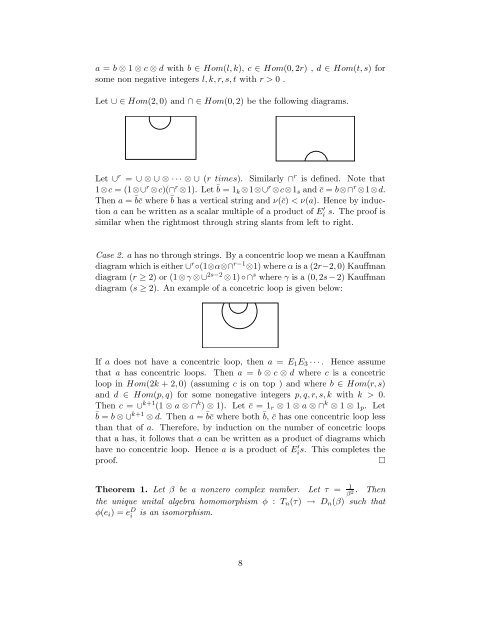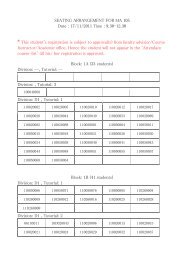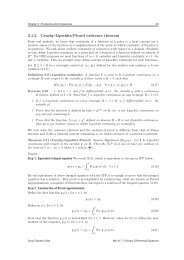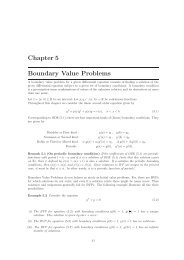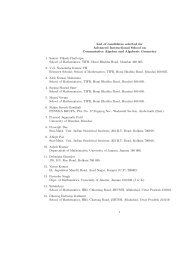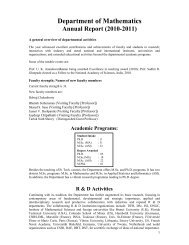the Masters' Thesis of S. Sundar
the Masters' Thesis of S. Sundar
the Masters' Thesis of S. Sundar
You also want an ePaper? Increase the reach of your titles
YUMPU automatically turns print PDFs into web optimized ePapers that Google loves.
a = b ⊗ 1 ⊗ c ⊗ d with b ∈ Hom(l,k), c ∈ Hom(0,2r) , d ∈ Hom(t,s) for<br />
some non negative integers l,k,r,s,t with r > 0 .<br />
Let ∪ ∈ Hom(2,0) and ∩ ∈ Hom(0,2) be <strong>the</strong> following diagrams.<br />
Let ∪r = ∪ ⊗ ∪ ⊗ · · · ⊗ ∪ (r times). Similarly ∩r is defined. Note that<br />
1⊗c = (1⊗∪r ⊗c)(∩r ⊗1). Let ¯b = 1k ⊗1⊗∪ r ⊗c⊗1s and ¯c = b⊗∩r ⊗1⊗d.<br />
Then a = ¯b¯c where ¯b has a vertical string and ν(¯c) < ν(a). Hence by induction<br />
a can be written as a scalar multiple <strong>of</strong> a product <strong>of</strong> E ′ i s. The pro<strong>of</strong> is<br />
similar when <strong>the</strong> rightmost through string slants from left to right.<br />
Case 2. a has no through strings. By a concentric loop we mean a Kauffman<br />
diagram which is ei<strong>the</strong>r ∪ r ◦(1⊗α⊗∩ r−1 ⊗1) where α is a (2r−2,0) Kauffman<br />
diagram (r ≥ 2) or (1 ⊗γ ⊗ ∪ 2s−2 ⊗1) ◦ ∩ s where γ is a (0,2s −2) Kauffman<br />
diagram (s ≥ 2). An example <strong>of</strong> a concetric loop is given below:<br />
If a does not have a concentric loop, <strong>the</strong>n a = E1E3 · · · . Hence assume<br />
that a has concentric loops. Then a = b ⊗ c ⊗ d where c is a concetric<br />
loop in Hom(2k + 2,0) (assuming c is on top ) and where b ∈ Hom(r,s)<br />
and d ∈ Hom(p,q) for some nonegative integers p,q,r,s,k with k > 0.<br />
Then c = ∪k+1 (1 ⊗ a ⊗ ∩k ) ⊗ 1). Let ¯c = 1r ⊗ 1 ⊗ a ⊗ ∩k ⊗ 1 ⊗ 1p. Let<br />
¯b = b ⊗ ∪k+1 ⊗ d. Then a = ¯b¯c where both ¯b, ¯c has one concentric loop less<br />
than that <strong>of</strong> a. Therefore, by induction on <strong>the</strong> number <strong>of</strong> concetric loops<br />
that a has, it follows that a can be written as a product <strong>of</strong> diagrams which<br />
have no concentric loop. Hence a is a product <strong>of</strong> E ′ is. This completes <strong>the</strong><br />
pro<strong>of</strong>. �<br />
Theorem 1. Let β be a nonzero complex number. Let τ = 1<br />
β 2. Then<br />
<strong>the</strong> unique unital algebra homomorphism φ : Tn(τ) → Dn(β) such that<br />
φ(ei) = e D i is an isomorphism.<br />
8


